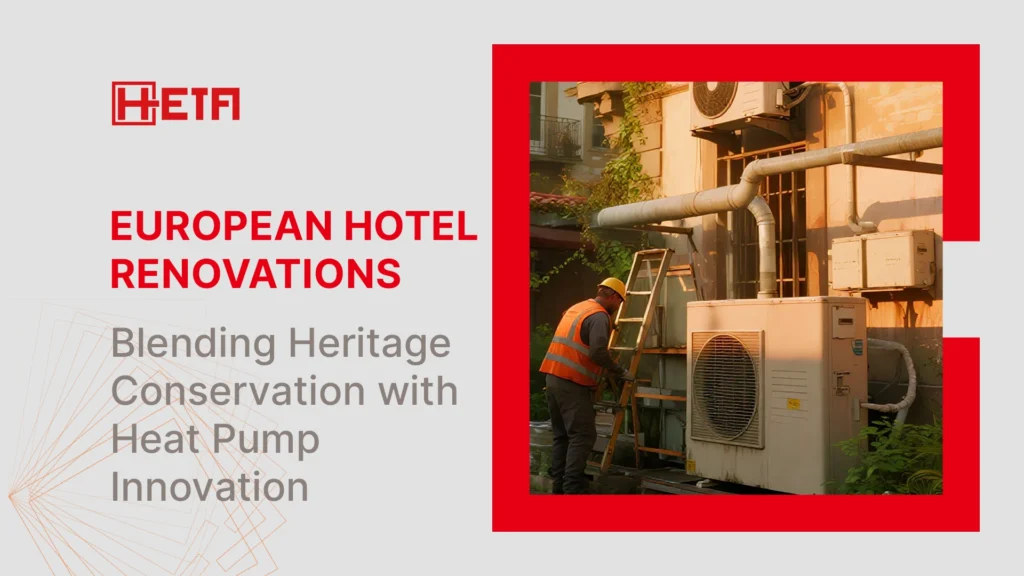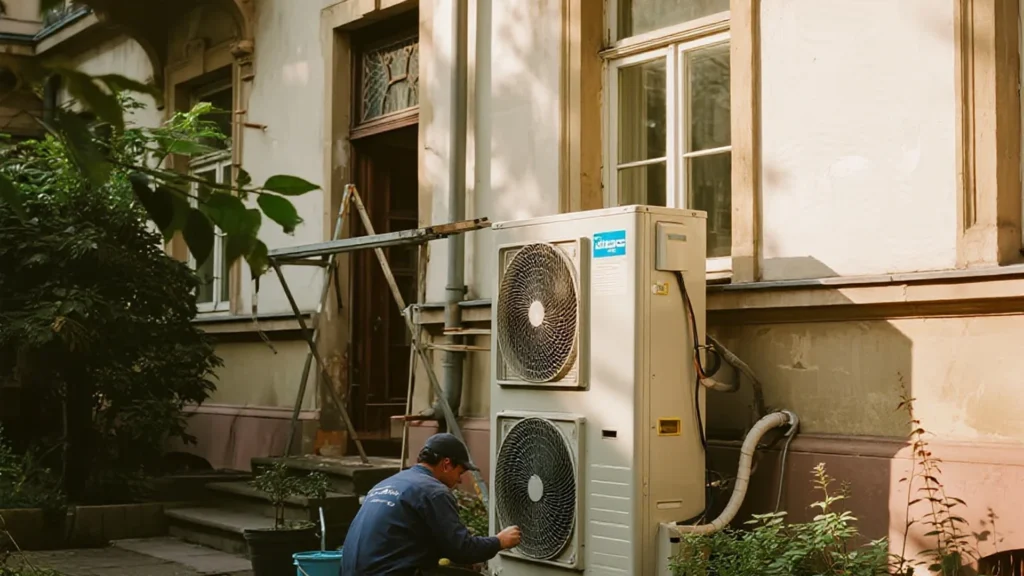
Table of Contents
1. Introduction: The Dual Drivers of Europe’s Hotel Renovation Wave
Europe’s hospitality sector is poised at a thrilling crossroads. On one side, cultural heritage demands preservation; on the other, sustainability demands innovation. This delicate dance is central to the continent’s hotel renovation boom. In Q1 2024 alone, Spain’s hotel renovation investments surged by 622%, totaling €19.58 billion—a data hook that underscores the enormity of this transformation.
Why such a surge? There are two key motivations drive it:
- Cultural Revival
Adaptive reuse breathes new life into historic structures. Imagine a 19th-century military barracks—with its thick masonry walls, arched corridors, and time-honored façades—becoming an ultra-luxury hotel. This is precisely what Kempinski did in Budapest, converting the old barracks into a five-star retreat. Beyond saving a landmark from decay, operators tap into travelers’ insatiable appetite for meaningful, story-rich experiences. - Regulatory Pressure
The European Union’s Energy Performance of Buildings Directive (EPBD) sets a daunting goal: a 55% reduction in building emissions by 2030. Meanwhile, Germany’s Gebäudeenergiegesetz (GEG) requires 65% of heating to come from renewable sources. Such mandates leave hoteliers little choice but to embrace low‑carbon technologies. Retrofitting with heat pumps—a cornerstone of renewable heating—emerges as an obvious solution.
Together, these forces shape a unique renovation wave: one that marries heritage conservation with heat pump innovation, ensuring historic hotels meet tomorrow’s energy benchmarks without losing their character.
2. Design Synergy: Where History Meets Sustainable Technology
How do you marry centuries‑old architecture with cutting‑edge engineering? The answer lies in design synergy—where history and sustainability converge seamlessly. Two landmark projects illustrate this balance.
Case Study 1: Kempinski Hotel Corvinus, Budapest
- Approach: Kempinski meticulously restored Neoclassical columns and ornate plasterwork in the grand ballroom. Beneath the marble floors, crews installed ground‑source heat pumps that tap into geothermal energy. This system achieved an impressive Seasonal Coefficient of Performance (SCOP) of 4.7, meaning for every 1 kWh of electricity consumed, 4.7 kWh of heat is delivered.
- Design Language: The interior palette fuses Hungarian folk motifs—bold reds, blues, and handcrafted fabrics—with sleek, modern furnishings. Six‑meter‑high ceilings hide discreet ductwork, delivering airflow without interrupting visual authenticity. Guests enjoy state‑of‑the‑art climate control, unaware of the geothermal marvel beneath their feet.
Case Study 2: Four Seasons Palazzo Volpi, Venice (2025 Launch)
- Challenge: Heating a 14th-century Gothic palazzo risks damaging priceless frescoes and dampening delicate mortar. Conventional radiators and ductwork would mar the centuries‑old aesthetic.
- Solution: Engineers deployed low‑vibration brine‑to‑water heat pumps, paired with humidity‑controlled ventilation systems. This combination gently warms the stone floors and walls, maintaining stable humidity levels crucial for fresco preservation. Integrated sensors adjust operations in real time, ensuring the building’s structural integrity and priceless artwork remain untouched.
These case studies demonstrate that heat pump integration need not conflict with heritage conservation. Instead, thoughtful design can accentuate historical beauty while delivering modern comfort.

3. Heat Pump Deployment: Technical Solutions by Hotel Tier
Not all hotels are created equal. From grand palaces to midscale coastal retreats, each property type demands a tailored heat pump solution. Here’s how the technology scales across tiers.
3.1 Luxury & Heritage Sites
Geothermal Systems
- Monastero Arx Vivendi, Italy: This 17th‑century monastery features a thermal spa renovated with ground‑source heat pumps. By circulating fluid through buried loops beneath the monastery’s cloister garden, the system provides consistent spa water temperatures with minimal energy input. Guests soak in geothermal-heated pools without disrupting the historical cloister’s stonework or garden layout.
Stealth Integration
- The Edinburgh Grand, Scotland: Victorian cornices and carved wood panels conceal networked pipes carrying heated water from vertical borehole heat exchangers outside the historic façade. Maintenance access points are hidden behind linen closets, ensuring technicians can service the system without exposing any modern objects to guests.
3.2 Midscale & Coastal Properties
Air-to-Water Heat Pumps
- Paparica Hotel, Portugal: Situated on a windswept Atlantic coast, this four‑star resort faces corrosive sea air. Operators installed marine‑grade air‑to‑water heat pumps with anti‑corrosion coatings. Coupled with a PV hybrid system, the hotel slashed grid reliance by 60%. During peak sunshine, solar panels directly power heat pump compressors; at night, grid electricity fills the gap.
Cold-Climate Technology
- A‑Rosa Alpina, Austria: Perched at 1,800 m altitude, this ski lodge needs heating even when temperatures plunge below −25 °C. Standard air-source units would freeze up. Instead, A‑Rosa uses specialized heat pumps with smart defrost cycles and inverter compressors that modulate speed, ensuring continuous operation during bitter alpine nights.
4. Policy Incentives & ROI Analysis
Underpinning these renovations are financial levers—subsidies, grants, and non‑financial benefits that tip ROI in favor of heat pumps.
4.1 EU Heat Pump Grants Comparison
| Country | Maximum Grant | Requirements | Verified Impact |
|---|---|---|---|
| Germany | 70% of costs | Application before 2028 deadline | Berlin boutique hotel: 4‑year payback |
| France | €9,000 per system | Mandatory fossil‑fuel replacement | Lyon Cour des Loges: 32% energy savings |
| Sweden | 30% tax credit | Must achieve Energy Class A++ | Stockholm Ett Hem: 0% gas dependency |
These figures highlight that public funding can cover a significant share of upfront costs, accelerating payback periods from the typical 5–7 years down to as little as 3 years.
4.2 Non-Financial Gains
Beyond direct subsidies, operators reap intangible benefits:
- LEED/BREEAM Certification Premiums: The Conservatorium Hotel in Amsterdam upgraded to BREEAM Outstanding, enabling a 15% increase in room rates thanks to eco‑conscious branding.
- Brand Value Uplift: The Venice Gritti Palace repositioned itself as a “Green Luxury” icon, capturing new segments of affluent travelers willing to pay a premium for sustainability credentials.
In short, heat pump renovations pay back both in hard euros and in brand equity that translates into higher occupancy, RevPAR, and guest loyalty.
4.3 EU Renovation Wave: The Macro Framework Driving Deep Retrofits
The European Commission’s Renovation Wave is the flagship programme of the European Green Deal aimed at doubling the annual energy renovation rate across both public and private buildings, with a target of 35 million buildings renovated by 2030. Its core objectives go beyond mere carbon reduction—to boost economic recovery post‑COVID, create local green jobs, and improve living standards through lower energy bills and healthier indoor environments.
Key measures include:
- Strengthening information, legal certainty and incentives for building owners and tenants to renovate.
- Ensuring adequate, well‑targeted funding by blending direct EU investment with leveraged private capital.
- Increasing technical assistance to regional and local actors, including skills‑training initiatives such as BUILD UP Skills.
- Promoting smart, digital‑ready renovations and sustainable materials across the construction sector.
- Leveraging renovation to address energy poverty, helping the 40 million Europeans unable to properly heat their homes.
- Decarbonising heating and cooling, the single largest source of building emissions.
For hotels, this means both greater financial support (through Enhanced Cohesion Funds, the Modernisation Fund, and Recovery and Resilience Facility disbursements) and clear regulatory signals. Any renovation project that integrates a low‑carbon heating solution—like heat pumps—now benefits from a more streamlined approval process, stronger grant availability, and technical‑assistance networks at local and regional levels. This macro‑policy framework not only accelerates ROI but also de‑risks long‑term investments, making deep, heritage‑sensitive retrofits both economically and technically feasible.
5. Overcoming Technical Constraints
Historic buildings present unique challenges. Walls weren’t designed for modern pipework; electrical panels weren’t conceived with digital controls in mind. Here’s how top hotels tackled these constraints.
5.1 Structural Challenges
Pipe Routing
- Corinthia Budapest: Flexible PEX piping snakes through former servant corridors and service shafts. Radial column systems allow each floor to have an independent supply and return loop, minimizing pressure loss and enabling individual floor temperature control.
Load Management
- Hotel Apple, South Tyrol: To avoid oversizing equipment, the property installed AI‑driven heat pump controllers. These learn occupancy patterns—guest arrival times, spa usage peaks—and dynamically adjust capacity, shaving 38% off idle‑period consumption.
5.2 System Integration
- Park Hotel Franceschi, Cortina d’Ampezzo: This alpine retreat integrated geothermal heat, a PV array, and a Tesla Powerwall into a hyper‑efficient microgrid. Excess solar electricity charges the Powerwall during long summer days; winter geothermal heaters draw from both grid and on‑site storage to maintain guest comfort during snowstorms.
By anticipating bottlenecks—whether in pipe routing, load fluctuations, or grid outages—these hotels ensure reliable performance and guest satisfaction.
6. Future-Proofing Strategies
While 2030 looms large, visionary operators are planning even further ahead.
6.1 Technology Roadmap
Hydrogen-Ready Heat Pumps
- Charles Hotel, Munich: A pilot installation uses dual‑fuel compressors capable of burning low‑emission hydrogen once supply chains mature. Today they run on electricity; tomorrow they’ll pivot to hydrogen, ensuring compliance with tightening carbon targets without new capital outlays.
Digital Twins
- Augustine Hotel, Prague: Engineers built a 3D digital twin of the heritage site, simulating HVAC impacts before any physical work began. This allowed them to tweak airflow pathways, heating curves, and insulation layers in virtual space, drastically reducing on‑site trial‑and‑error and avoiding damage to protected surfaces.
6.2 Emerging Markets
Southern Europe: Portugal’s Surf Hotel Corridor
- Coastal towns like Nazaré and the Algarve have seen an influx of surf‑themed eco‑lodges. These properties pair compact air‑to‑water heat pumps with heat recovery ventilation, achieving both comfort and energy savings in humid maritime climates.
Eastern Europe: Poland’s “Clean Heat” Program
- Kraków’s Old Town, with its medieval townhouses, is at the vanguard of Poland’s retrofit wave. Generous grants fund heat pump installations in listed buildings, breathing new life into UNESCO‑protected streetscapes.
These future‑proof strategies underscore a fundamental truth: sustainability and heritage preservation aren’t mutually exclusive—they’re mutually reinforcing.
7. Actionable Insights for Hotel Operators
Ready to transform your property? Here’s a two‑pronged roadmap.
7.1 Immediate Steps
- Audit Your Existing HVAC
Benchmark performance against 2027 EU emissions targets. Identify boiler replacements, duct leaks, and sub‑optimal controls. - Secure Early-Stage Funding
Lock in German or UK subsidies before 2028 phase‑outs. Engage local energy consultants to streamline applications. - Partner with Heritage‑Aware Installers
Choose contractors experienced in concealed installations and conservation‑grade practices.
7.2 Long-Term Playbook
- Adopt the “Heat Pump + Cultural IP + IoT Monitoring” Framework:
Model your strategy on Kempinski Budapest: combine storytelling (cultural IP) with high‑efficiency heat pumps and real‑time digital dashboards delivered via IoT. - Leverage Sustainability Branding:
Craft guest experiences—wellness programs, historic tours, eco‑dining—that spotlight your green credentials. Use social media and travel PR to amplify your “green luxury” narrative. - Stay Ahead of Regulations:
Monitor EU directives and local building codes. Invest in modular systems—like hydrogen‑ready compressors and digital twins—that allow mid‑project pivots as policies evolve.
By embedding these insights in your renovation project, you can deliver on environmental goals, captivate guests, and safeguard your ROI.
8. Conclusion
Europe’s hotel renovation renaissance is a testament to the region’s ability to honor the past while embracing the future. From the ornate halls of the Kempinski Budapest to the cloistered gardens of Monastero Arx Vivendi, heat pump innovation empowers hoteliers to achieve stringent emissions targets without compromising architectural integrity.
Whether you manage a Gothic palazzo in Venice or an ocean‑view inn in Portugal, the path to sustainable luxury lies in meticulously planned heat pump integration, backed by strategic subsidies and future‑proof technologies. By following the design, technical, and financial playbooks outlined above, hotel operators can transform heritage properties into paragons of energy efficiency, guest comfort, and brand prestige—ensuring these treasured landmarks thrive for generations to come.




